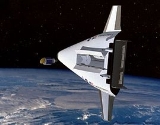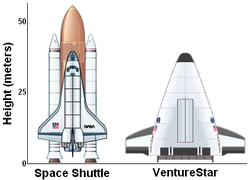
VentureStar
Encyclopedia
VentureStar was a proposed spaceplane
design for a single-stage-to-orbit
reusable launch system
by Lockheed Martin
. The program's primary goal as a United States federally funded program was to develop a reusable unmanned spaceplane for launching satellites into orbit at a fraction of the cost of other systems that would completely replace the Space Shuttle
. While the requirement was for an unmanned launcher, it was expected to optionally carry passengers as cargo.
VentureStar was to be a single-stage-to-orbit
vehicle that would take off vertically and land like an airplane. VentureStar was to be a commercial endeavor, and flights would have been leased to NASA
as needed. After failures with the X-33
subscale technology demonstrator test vehicle, funding was canceled in 2001.
 VentureStar's engineering and design offered numerous advantages over the Space Shuttle
VentureStar's engineering and design offered numerous advantages over the Space Shuttle
, representing considerable savings in time and materials, as well as increased safety. VentureStar could launch satellites into orbit at about 1/10 the cost of the Shuttle.
Readying VentureStar for flight would be dramatically different from that of the Space Shuttle. Unlike the Shuttle Orbiter, which must be lifted and assembled together with several other heavy components (a large external tank, plus two solid rocket booster
s) the VentureStar would be simply inspected in a hangar
like an airplane.
Also unlike the Space Shuttle, VentureStar would have not relied upon solid rocket booster
s which must be hauled out of the ocean and then refurbished after every launch. Furthermore, the design specifications call for the use of linear aerospike engine
s, which maintain efficient thrust at all altitudes. The Shuttle relies upon the conventional nozzle engine which achieves maximum efficiency at only one specific altitude.
VentureStar would have used a new metallic thermal protection system
that would be safer and cheaper to maintain than the ceramic one on the Space Shuttle. VentureStar's metallic heat shield would eliminate 17,000 between-flight maintenance hours currently required to satisfactorily check (and replace if needed) each of the thousands of heat-resistant ceramic tiles which currently make up the Shuttle exterior.
VentureStar was anticipated to be safer than modern rockets. Whereas today's rockets fail catastrophically when an engine fails during flight, VentureStar would have a thrust reserve in each engine for the event of an emergency during flight. For example, if an engine on VentureStar was to have failed during an ascent to orbit, another engine opposite to the failed engine would shut off to counterbalance the failed thrust, and each of the remaining working engines could have been throttled up so as to safely continue the mission.
VentureStar would have been environmentally cleaner. Unlike the Space Shuttle, whose solid rocket boosters expend chemical wastes during launch, VentureStar's exhausts would have been composed of only water vapor, since VentureStar's main fuels would be only liquid hydrogen
and liquid oxygen
. VentureStar's simpler design would have excluded hypergolic propellant
s and even hydraulics, relying upon only electrical power instead for flight controls, doors and landing gear.
Because of its lighter design, VentureStar would have been able to land at virtually any major airport in an emergency, whereas the Space Shuttle requires much longer runways than publicly available.
Spaceplane
A spaceplane is a vehicle that operates as an aircraft in Earth's atmosphere, as well as a spacecraft when it is in space. It combines features of an aircraft and a spacecraft, which can be thought of as an aircraft that can endure and maneuver in the vacuum of space or likewise a spacecraft that...
design for a single-stage-to-orbit
Single-stage-to-orbit
A single-stage-to-orbit vehicle reaches orbit from the surface of a body without jettisoning hardware, expending only propellants and fluids. The term usually, but not exclusively, refers to reusable vehicles....
reusable launch system
Reusable launch system
A reusable launch system is a launch system which is capable of launching a launch vehicle into space more than once. This contrasts with expendable launch systems, where each launch vehicle is launched once and then discarded.No true orbital reusable launch system is currently in use. The...
by Lockheed Martin
Lockheed Martin
Lockheed Martin is an American global aerospace, defense, security, and advanced technology company with worldwide interests. It was formed by the merger of Lockheed Corporation with Martin Marietta in March 1995. It is headquartered in Bethesda, Maryland, in the Washington Metropolitan Area....
. The program's primary goal as a United States federally funded program was to develop a reusable unmanned spaceplane for launching satellites into orbit at a fraction of the cost of other systems that would completely replace the Space Shuttle
Space Shuttle
The Space Shuttle was a manned orbital rocket and spacecraft system operated by NASA on 135 missions from 1981 to 2011. The system combined rocket launch, orbital spacecraft, and re-entry spaceplane with modular add-ons...
. While the requirement was for an unmanned launcher, it was expected to optionally carry passengers as cargo.
VentureStar was to be a single-stage-to-orbit
Single-stage-to-orbit
A single-stage-to-orbit vehicle reaches orbit from the surface of a body without jettisoning hardware, expending only propellants and fluids. The term usually, but not exclusively, refers to reusable vehicles....
vehicle that would take off vertically and land like an airplane. VentureStar was to be a commercial endeavor, and flights would have been leased to NASA
NASA
The National Aeronautics and Space Administration is the agency of the United States government that is responsible for the nation's civilian space program and for aeronautics and aerospace research...
as needed. After failures with the X-33
Lockheed Martin X-33
The Lockheed Martin X-33 was an unmanned, sub-scale technology demonstrator suborbital spaceplane developed in the 1990s under the U.S. government-funded Space Launch Initiative program. The X-33 was a technology demonstrator for the VentureStar orbital spaceplane, which was planned to be a...
subscale technology demonstrator test vehicle, funding was canceled in 2001.
Advantages over the Space Shuttle

Space Shuttle
The Space Shuttle was a manned orbital rocket and spacecraft system operated by NASA on 135 missions from 1981 to 2011. The system combined rocket launch, orbital spacecraft, and re-entry spaceplane with modular add-ons...
, representing considerable savings in time and materials, as well as increased safety. VentureStar could launch satellites into orbit at about 1/10 the cost of the Shuttle.
Readying VentureStar for flight would be dramatically different from that of the Space Shuttle. Unlike the Shuttle Orbiter, which must be lifted and assembled together with several other heavy components (a large external tank, plus two solid rocket booster
Solid rocket booster
Solid rocket boosters or Solid Rocket Motors, SRM, are used to provide thrust in spacecraft launches from the launchpad up to burnout of the SRBs. Many launch vehicles include SRBs, including the Ariane 5, Atlas V , and the NASA Space Shuttle...
s) the VentureStar would be simply inspected in a hangar
Hangar
A hangar is a closed structure to hold aircraft or spacecraft in protective storage. Most hangars are built of metal, but other materials such as wood and concrete are also sometimes used...
like an airplane.
Also unlike the Space Shuttle, VentureStar would have not relied upon solid rocket booster
Solid rocket booster
Solid rocket boosters or Solid Rocket Motors, SRM, are used to provide thrust in spacecraft launches from the launchpad up to burnout of the SRBs. Many launch vehicles include SRBs, including the Ariane 5, Atlas V , and the NASA Space Shuttle...
s which must be hauled out of the ocean and then refurbished after every launch. Furthermore, the design specifications call for the use of linear aerospike engine
Aerospike engine
The aerospike engine is a type of rocket engine that maintains its aerodynamic efficiency across a wide range of altitudes through the use of an aerospike nozzle. It is a member of the class of altitude compensating nozzle engines. A vehicle with an aerospike engine uses 25–30% less fuel at low...
s, which maintain efficient thrust at all altitudes. The Shuttle relies upon the conventional nozzle engine which achieves maximum efficiency at only one specific altitude.
VentureStar would have used a new metallic thermal protection system
Space shuttle thermal protection system
The Space Shuttle thermal protection system is the barrier that protects the Space Shuttle Orbiter during the searing heat of atmospheric reentry...
that would be safer and cheaper to maintain than the ceramic one on the Space Shuttle. VentureStar's metallic heat shield would eliminate 17,000 between-flight maintenance hours currently required to satisfactorily check (and replace if needed) each of the thousands of heat-resistant ceramic tiles which currently make up the Shuttle exterior.
VentureStar was anticipated to be safer than modern rockets. Whereas today's rockets fail catastrophically when an engine fails during flight, VentureStar would have a thrust reserve in each engine for the event of an emergency during flight. For example, if an engine on VentureStar was to have failed during an ascent to orbit, another engine opposite to the failed engine would shut off to counterbalance the failed thrust, and each of the remaining working engines could have been throttled up so as to safely continue the mission.
VentureStar would have been environmentally cleaner. Unlike the Space Shuttle, whose solid rocket boosters expend chemical wastes during launch, VentureStar's exhausts would have been composed of only water vapor, since VentureStar's main fuels would be only liquid hydrogen
Liquid hydrogen
Liquid hydrogen is the liquid state of the element hydrogen. Hydrogen is found naturally in the molecular H2 form.To exist as a liquid, H2 must be pressurized above and cooled below hydrogen's Critical point. However, for hydrogen to be in a full liquid state without boiling off, it needs to be...
and liquid oxygen
Liquid oxygen
Liquid oxygen — abbreviated LOx, LOX or Lox in the aerospace, submarine and gas industries — is one of the physical forms of elemental oxygen.-Physical properties:...
. VentureStar's simpler design would have excluded hypergolic propellant
Propellant
A propellant is a material that produces pressurized gas that:* can be directed through a nozzle, thereby producing thrust ;...
s and even hydraulics, relying upon only electrical power instead for flight controls, doors and landing gear.
Because of its lighter design, VentureStar would have been able to land at virtually any major airport in an emergency, whereas the Space Shuttle requires much longer runways than publicly available.
Cancellation
Failures in VentureStar's technology demonstrator, the X-33, in particular with the composite LH2 (liquid hydrogen) tank, led to program cancellation as a federal undertaking on February, 2001.See also
- Lockheed Martin X-33Lockheed Martin X-33The Lockheed Martin X-33 was an unmanned, sub-scale technology demonstrator suborbital spaceplane developed in the 1990s under the U.S. government-funded Space Launch Initiative program. The X-33 was a technology demonstrator for the VentureStar orbital spaceplane, which was planned to be a...
- Skylon (spacecraft)

